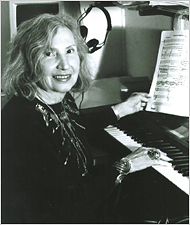Name Ruth Schonthal | Role Composer | |
 | ||
Education Stern Conservatory, Yale University, Royal Academy of Music Similar People Isabella Leonarda, Louise Farrenc, Fanny Mendelssohn, Amy Beach, Hanns Eisler | ||
Ruth schonthal in homage of 24 preludes alec chien pianist
Ruth Schönthal (June 27, 1924 in Hamburg, Germany – July 10, 2006 in Scarsdale, New York) was a pianist and contemporary composer.
Contents
- Ruth schonthal in homage of 24 preludes alec chien pianist
- Ruth schonthal string quartet no 1 york string quartet
- Early years
- Musical compositions
- Awards
- Interviews
- Selected works
- Discography
- References
Ruth schonthal string quartet no 1 york string quartet
Early years
Ruth Schönthal was born in Hamburg of Viennese parents. At the age of five she began composing and became the youngest student ever accepted at the Stern'sches Konservatorium in Berlin. In 1935, Schönthal and her family were forced to leave Nazi Germany for Stockholm on account of her Jewish heritage. She later studied at the Royal Academy of Music (RAM) in Stockholm, where at the age of fourteen, she had her first sonatina published. At the RAM she studied composition with Ingemar Liljefors and piano with Olaf Wibergh. Then, she was once again forced to flee as a result of the rising political tension, and eventually traveled to a variety of places: first the USSR, then Japan, and then Mexico City, where at the age of 19 she gave a very widely acclaimed piano performance of her own compositions, including her First Piano Concerto, at the Palacio de Bellas Artes. Among the audience members was the noted German composer Paul Hindemith, who obtained a scholarship for her to study with him at Yale in 1946. She was one of the few of Hindemith's students to graduate from the Conservatory with honors.
Schönthal married the painter Paul Seckel in 1950 and settled in New York City, eventually moving to New Rochelle, where she lived for most of her life She is the mother of Al Seckel, an authority on visual illusions.
Schönthal received commissions for chamber music, operas, symphonic compositions, as well as works for organ and piano. She taught composition and music theory at NYU until 2006 when deteriorating health forced her to resign. She also taught composition and piano privately and was the first composition teacher of American composer Lowell Liebermann. One close student of hers, between 2003 and 2005, the unknown Stephanie Germanotta, went on to great fame in the pop music world as Lady Gaga. Schönthal used her music to support herself and her family throughout her life: she wrote for television and commercials, played the piano in various bars and clubs, and taught privately in New York.
Her works are widely performed in the US and abroad, but her music is perhaps most well known in her native Germany. Her music is published by Oxford University Press, Southern Music Co, Carl Fischer, G. E. Schirmer, Sisra Press, Fine Arts Music Co, Hildegard Music Publishing Co, nd Furore and recorded on LP on the Capriccio, Crystal, Leonarda, Opus One and Orion Labels, many of them reissued on CDs on the Leonarda and Cambria labels.
Musical compositions
Schönthal's style is vaguely classified by Catherine Parsons Smith as “impressionist”, with a greater emphasis on the fact that it strove to break free of Hindemith’s influence. Her style is a fusion of several different techniques, both traditional and contemporary, and her compositions are meant to reflect the concerns of today’s world (Composer’s Bureau). New Grove records her as being isolated from her composing contemporaries, which enabled her to distance herself from many contemporary trends of composition and allowed her to develop a compositional voice stemming from a classical-romantic heritage (Composer’s Bureau). Her learning process, extending over several continents, certainly contributed to her diverse music as well.
Awards
In 1994 she received the Internationaler Kunstlerinnen Preis of the City of Heidelberg, and was honored with an exhibition of her life and works at the Prinz Carl am Kommarkt Museum there. In the United States, she received several Meet the Composer grants and ASCAP awards, and a Delta Omicron International award for her first string quartet. She received a Certificate of Merit from Yale for Outstanding Service to Music, and an Outstanding Musician Award from New York University. Amazingly, she also reached the finalist stage in the New York City Opera Competition (“The Courtship of Camilla”), as well as in the Kennedy-Friedheim Competition with her 24 Prelude set, entitled “In Homage of . . .”
